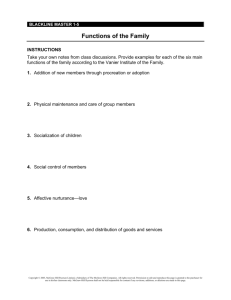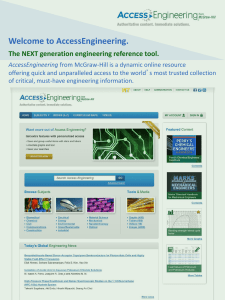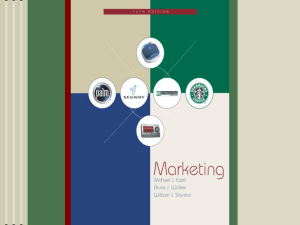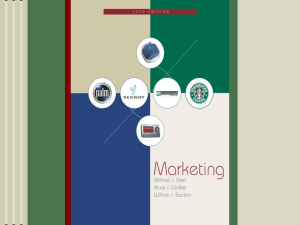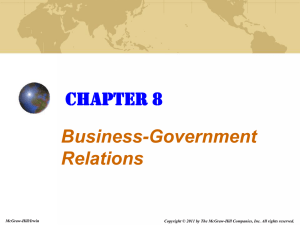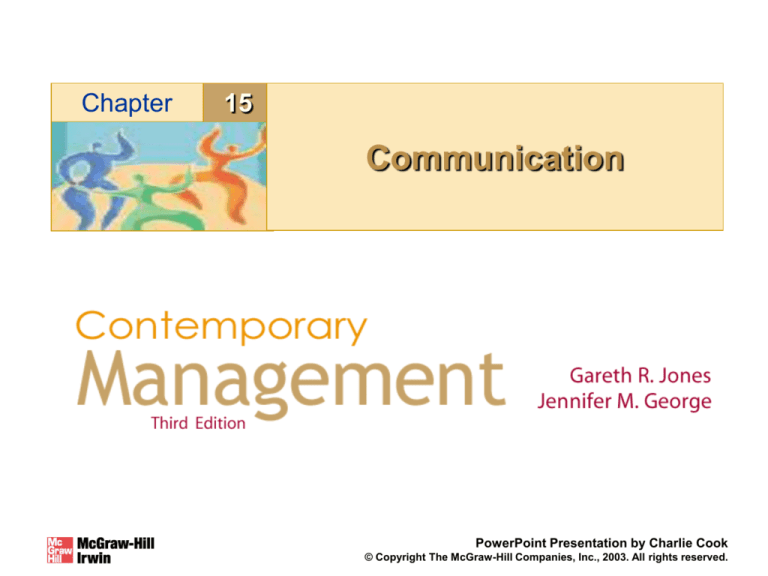
Chapter
15
Communication
PowerPoint Presentation by Charlie Cook
© Copyright The McGraw-Hill Companies, Inc., 2003. All rights reserved.
Learning Objectives
• After studying the chapter, you should be able to:
Explain why effective communication helps an
organization gain a competitive advantage.
Describe the communication process, and explain
the role of perception in communication.
Define information richness, and describe the
information richness of communication media
available to managers.
Describe the communication networks that exist in
groups and teams.
© Copyright McGraw-Hill. All rights reserved.
15–2
Learning Objectives (cont’d)
Explain how advances in technology have given
managers new options for managing
communications.
Describe important communication skills that
managers need as senders and receivers of
messages.
© Copyright McGraw-Hill. All rights reserved.
15–3
Chapter Outline
• Communication and Management
The Importance of Good Communication
The Communication Process
The Role of Perception in Communication
The Dangers of Ineffective Communication
Information Richness and Communication Media
Face-to-Face Communication
Spoken Communication Electronically
Communicated
Personally Addressed Written Communication
© Copyright McGraw-Hill. All rights reserved.
15–4
Chapter Outline (cont’d)
• Communication and Management (cont’d)
Impersonal Written Communication
• Communication Networks
Communication Networks in Groups and Teams
Organizational Communication Networks
External Networks
• Technological Advances in Communication
The Internet
Intranets
Groupware
© Copyright McGraw-Hill. All rights reserved.
15–5
Chapter Outline (cont’d)
• Communication Skills for Managers
Communication Skills for Managers as Senders
Communication Skills for Managers as Receivers
Understanding Linguistic Styles
© Copyright McGraw-Hill. All rights reserved.
15–6
Communication and Management
• Communication
The sharing of information between two or more
individuals or groups to reach a common
understanding.
• Importance of Good Communication
Increased efficiency in new technologies and skills
Improved quality of products and services
Increased responsiveness to customers
More innovation through communication
© Copyright McGraw-Hill. All rights reserved.
15–7
The Communication Process
• Phases of the Communication Process:
Transmission phase in which information is shared
by two or more people.
Feedback phase in which a common understanding
is assured.
• The process starts with a sender (an individual
or group) who wants to share information.
Senders must decide what information to share and
puts the message into symbols or language
(encoding).
• Noise: anything harming the communication process.
© Copyright McGraw-Hill. All rights reserved.
15–8
The Communication Process
Figure 15.1
© Copyright McGraw-Hill. All rights reserved.
15–9
The Communication Process (cont’d)
• Messages are transmitted over a medium to a
receiver.
Medium: the pathway over which the message is
transmitted (e.g., telephone, written note, email).
Receiver: the person getting the message.
• The receiver decodes (interprets) the message,
allowing the receiver to understand the message.
• This is a critical point: failure to properly decode the
message can lead to a misunderstanding.
Feedback by receiver informs the sender that the
message is understood or that it must be re-sent.
© Copyright McGraw-Hill. All rights reserved.
15–10
Communication Issues
• Verbal Communication
The encoding of messages into words, either
written or spoken
• Nonverbal
The encoding of messages by means of facial
expressions, body language, and styles of dress.
© Copyright McGraw-Hill. All rights reserved.
15–11
The Role of Perception in Communication
• Senders and receivers communicate based on
their subjective perceptions.
Subjective perception can lead to biases and
stereotypes that can interfere with effective
communication.
Effective managers avoid communications based on
biases and stereotypes.
© Copyright McGraw-Hill. All rights reserved.
15–12
The Dangers of Ineffective Communication
• Managers and their subordinates can become
effective communicators by:
Selecting an appropriate medium for each
message—there is no one “best” medium.
Considering information richness (the amount of
information a medium can carry).
• A medium with high richness can carry much more
information to aid understanding.
Is there a need for a paper path or electronic trail
to provide documentation of the communication?
© Copyright McGraw-Hill. All rights reserved.
15–13
Information Richness of Communication Media
Figure 15.2
© Copyright McGraw-Hill. All rights reserved.
15–14
Communication Media
• Face-to-Face
Has highest information richness.
Can take advantage of verbal and nonverbal
signals.
Provides for instant feedback.
• Management by wandering around takes advantage
of this with informal talks to workers.
• Video conferences provide
much of this richness and
reduce travel costs and
meeting times.
© Copyright McGraw-Hill. All rights reserved.
15–15
Communication Media (cont’d)
• Spoken Communication Electronically
Transmitted
Has the second highest information richness.
• Telephone conversations are information rich with
tone of voice, sender’s emphasis, and quick
feedback, but provide no visual nonverbal cues.
© Copyright McGraw-Hill. All rights reserved.
15–16
Communication Media (cont’d)
• Personally Addressed Written Communication
Has a lower richness than the verbal forms of
communication, but still is directed at a given
person.
• Personal addressing helps ensure receiver actually
reads the message—personal letters and e-mail are
common forms.
• Does not provide instant feedback to the sender
although sender may get feedback later.
• Excellent media for complex messages requesting
follow-up actions by receiver.
© Copyright McGraw-Hill. All rights reserved.
15–17
E-Mail Dos and Don’ts
• E-mail allows telecommuting employees to
work from home and keep in contact.
• The use of e-mail is growing rapidly and email etiquette is expected:
Typing messages in all CAPITALS is seen as
“screaming” at the receiver.
Punctuate your messages for easy reading and
don’t ramble on.
Pay attention to spelling and treat the message like
a written letter.
© Copyright McGraw-Hill. All rights reserved.
15–18
Communication Media (cont’d)
• Impersonal Written Communication
Has the lowest information richness.
• Good for messages to many receivers where little or
feedback is expected (e.g., newsletters, reports)
© Copyright McGraw-Hill. All rights reserved.
15–19
Communication Networks
• Communication Networks
The pathways along which information flows in
groups and teams and throughout the
organization.
Choice of communication network depends on:
• The nature of the group’s tasks
• The extent to which group members need to
communicate with each other to achieve group goals.
© Copyright McGraw-Hill. All rights reserved.
15–20
Communication Networks in
Groups and Teams
Type of Network
Wheel Network
Information flows to and from one central
member.
Chain Network
Members communicate only with the people next
to them in the sequence.
Wheel and chain networks provide little interaction.
Circle Network
Members communicate with others close to them
in terms of expertise, experience, and location.
All-Channel
Network
Networks found in teams with high levels of
communications between each member and all
others.
© Copyright McGraw-Hill. All rights reserved.
15–21
Communication
Networks in
Groups and
Teams
Figure 15.3
© Copyright McGraw-Hill. All rights reserved.
15–22
Organization Communication Networks
• Organization Chart
A pictorial representation of formal reporting
channels in an organization.
• Communication in an organization flows through
formal and informal pathways
• Vertical communications flow up and down the
corporate hierarchy.
• Horizontal communications flow between employees
of the same level.
• Informal communications can span levels and
departments—the grapevine is an informal network
carrying unofficial information throughout the firm.
© Copyright McGraw-Hill. All rights reserved.
15–23
Formal and Informal Communication
Networks in An Organization
Figure 0.4
© Copyright McGraw-Hill. All rights reserved.
15–24
Technological Advances in Communication
• Internet
Global system of computer networks used by many
firms use it to communicate with their suppliers.
• World Wide Web (WWW)
Provides multimedia access to the Internet.
• Intranets
A company-wide system of computer networks for
information sharing by employees inside the firm.
© Copyright McGraw-Hill. All rights reserved.
15–25
Technological Advances in Communication
• Groupware
Computer software that enables members of
groups and teams to share information with each
other and improve communication.
• Best used to support team-oriented working
environments.
© Copyright McGraw-Hill. All rights reserved.
15–26
Communication Skills for Managers
• Barriers to Effective Communication
Messages that are unclear, incomplete, difficult to
understand
Messages sent over the an inappropriate medium
Messages with no provision for feedback
Messages that are received but ignored
Messages that are misunderstood
Messages delivered through automated systems that
lack the human element
© Copyright McGraw-Hill. All rights reserved.
15–27
Communication Skills for Managers
• Managers as Senders
Send clear and complete messages.
Encode messages in symbols the receiver understands.
Select a medium appropriate for the message and,
importantly, one that is monitored by the receiver.
Avoid filtering (holding back information) and distortion
as the message passes through other workers.
Ensure a feedback mechanism is included in the
message.
Provide accurate information to avoid rumors.
© Copyright McGraw-Hill. All rights reserved.
15–28
Communication Skills For Managers
• Managers as Receivers
Pay attention to what is sent as a message.
Be a good listener: don’t interrupt.
Ask questions to clarify your understanding.
Be empathetic: try to understand what the sender
feels.
Understand linguistic styles: different people speak
differently.
Speed, tone, pausing all impact communication.
• This is particularly true across cultures and
managers should expect and plan for this.
© Copyright McGraw-Hill. All rights reserved.
15–29

